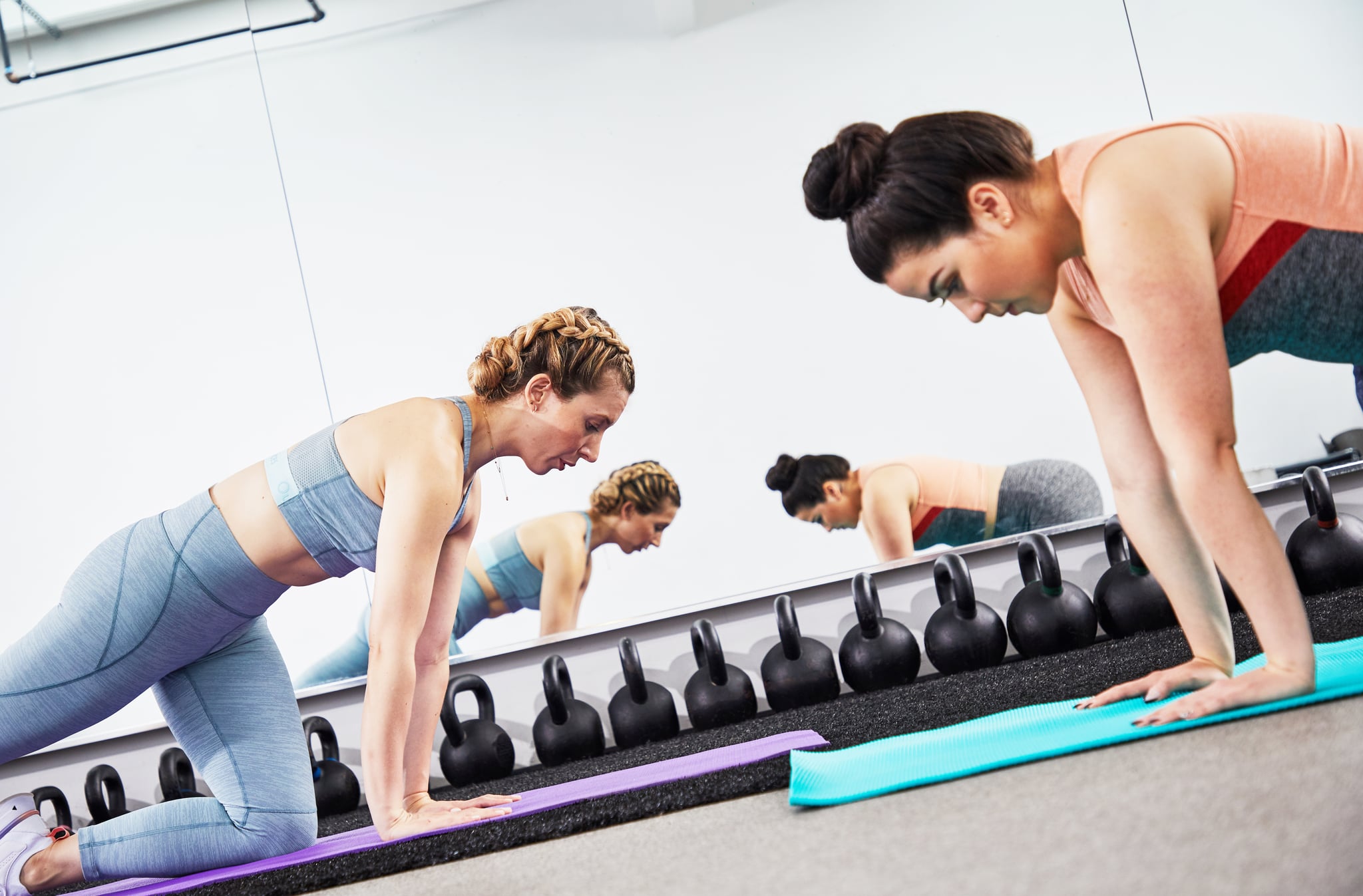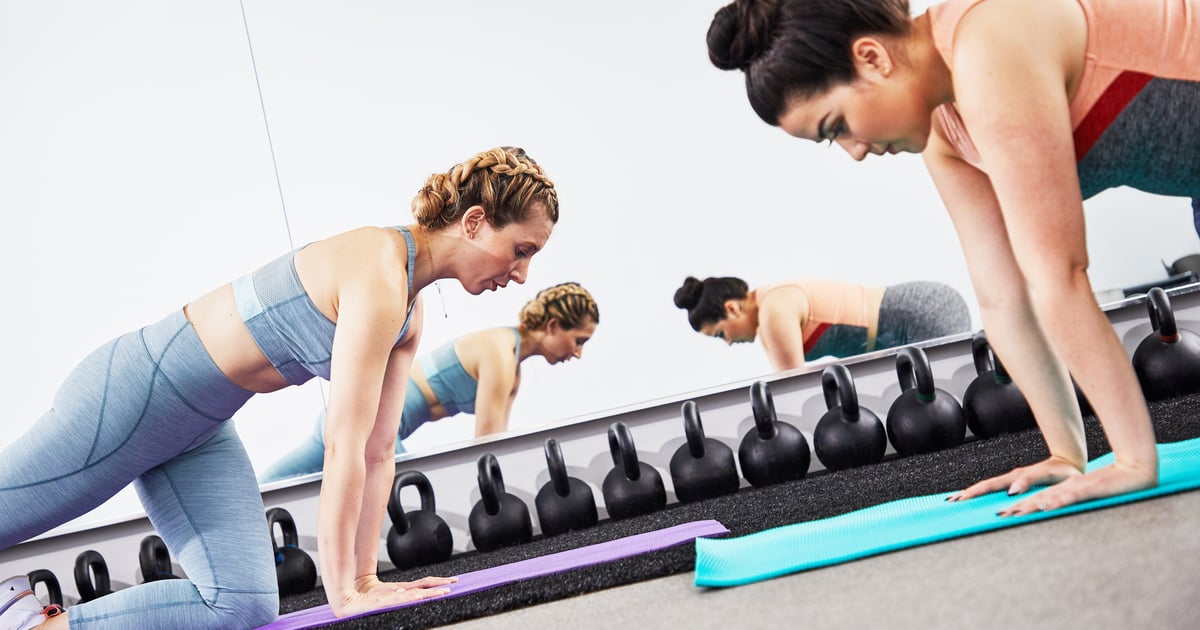
POPSUGAR Photography / Matthew Kelly
It wasn’t all that long ago that box jumps, burpees, and treadmill sprints likely dominated the fitness side of your social feed. Nowadays? I’ll bet it skews more toward things like hot girl walks and Pilates.
There’s been an undeniable shift in the fitness culture lately, and it’s seeming to steer away from brutal, bring-your-all type of workouts and toward ones that are, well, a bit more chill. A phrase that often accompanies the latter? “Low impact.”
Low-impact workouts are often touted as being great for your joints and beginner-friendly, and though it might feel like a niche category of exercise, there’s actually a whole lot that fits under the low-impact umbrella. The thing is, as is the case with many buzzy fitness terms that get co-opted for use even when they’re not accurate (see: people using “HIIT” to describe any literally workout), it’s unclear how many people truly understand what “low-impact” means.
Here, fitness pros set the record straight on the meaning of “low-impact” clear up some misconceptions about low-impact workouts and discuss why everyone should incorporate low-impact workouts into their routines.
What Does Low-Impact Mean, Exactly?
The general definition of “low-impact” is “involving movements that do not put a lot of stress on the body,” according to Oxford Dictionaries. While that’s true, it’s also pretty vague. After all, “all exercise is stress on the body, whether it’s high- or low-impact,” CITYROW founding instructor Annie Mulgrew tells POPSUGAR. “We want the body to be able to respond to stress effectively — that’s one reason why we exercise.”
What really makes a workout low-impact is when “you always have one foot on the floor at any given moment in your exercise,” says Justin Norris, cofounder of LIT Method, a low-impact training method. This means there’s no jumping. Think of it this way: “a low-impact workout is one in which your body is not being forced to brace itself for impact,” explains Mulgrew.
Low-impact workouts can also be described as more “fluid in movement” since they “create less stress on your joints as your feet or body meet the ground,” explains Xio Colon, personal training leader at Life Time Sky in Manhattan.
Impact vs. Intensity
Just because you’re doing a low-impact workout doesn’t necessarily mean you aren’t breaking a sweat. In fact, low-impact workouts can still be really freaking hard — and that’s because impact isn’t the same thing as intensity. However, people often get the two confused.
“Impact is the stress that a workout can have on your joints, whereas intensity is how much you’re challenging yourself,” explains Syndey Miller, certified Pilates instructor and creator of the HOUSEWORK workout program, which blends low-impact Pilates-style moves with high-intensity cardio and strength.
For example, a high-impact, high-intensity workout would be a set of burpees. “That’s going to increase your heart rate very quickly, and you’re also jumping and landing, so there’s impact against the body,” explains Mulgrew. Meanwhile, rowing is a high-intensity, low-impact workout, since “it’s non-weight bearing (since you’re seated), but you can row quickly or with power, and that’s going to increase the intensity at which your body is working,” she says. Then you can also have a low-intensity, low-impact workout, which would be something like going for a long walk on a flat surface. None of these are inherently better or worse than the others: “it really just depends on what your goals and intentions are,” Mulgrew says.
Which Workouts Are Low-Impact?
“Fitting low-impact workouts into your current exercise routine can be easier than you think,” Colon says. That’s because many workouts are inherently low-impact, such as Pilates, yoga, walking, cycling, swimming, and even strength training. And you can easily make a workout low-impact by removing or modifying any jumping moves. For example, a plyometric HIIT workout can be made low-impact if you swap out, say, squat jumps and do a squat to calf raise instead.
One exercise you can’t make low-impact, however, is running. Because you’re airborne for a brief moment while you’re transferring your weight from one leg to the other, running, by definition, is high impact. For that reason, sports that include running or agility, for example, (think: tennis, pickleball, soccer, and basketball) would all be considered high-impact.
Who Can Benefit From Low-Impact Workouts?
Honestly, everyone, says Norris. Because so much falls under the low-impact umbrella, there’s something there for everyone, no matter your needs and goals.
Notably, because your body and joints get less wear and tear from low-impact workouts, they can be a great choice for anyone who’s had an injury in the past or who wants to prevent injury in the future, says Miller. Not to mention, low-impact workouts are generally friendly for beginners or people coming back from a workout hiatus.
Why Is Everybody So Into Low-Impact Right Now?
The internet’s current love for low-impact exercise is real, from the 12-3-30 workout to reformer Pilates. But there are several reasons the trend has swung this way.
For one, “it just feels better,” says Mulgrew. “It allows people to connect with their bodies — it’s an inner-body experience rather than an out-of-body experience. Not to say that you can’t experience that mind-body connection when you’re doing more impactful things, but when the body doesn’t feel good when you’re doing it, it’s very distracting. All you can think about is the discomfort rather than the way that your body is moving.” Over the past decade, the cultural fitness narrative has shifted from being about aesthetics to being about abilities to being about mood and mental health — swapping unrealistic beauty standards for self-care. So it makes sense that people are starting to pick their workouts based on the feel-good factor rather than caloric payoff or body-changing promises.
This instinct to choose movement that feels good becomes even more relevant in the wake of a global pandemic. COVID pushed us to slow down life in all respects — including our workouts. “When you’re already in an emotionally stressful environment, which we all experienced, it’s really hard to get the body to do really impactful, hard, challenging workouts,” Mulgrew says. Low-impact workouts are apartment- and living room–friendly and often seem to have a lower barrier to entry, as far as effort is concerned.
Not to mention, they’re easier to stick with. “Moving in mostly low-impact ways feels really good on the body, so it’s easier to do more of; you can show up five or six days a week without feeling broken down,” Miller adds.
Miller, Mulgrew, and Norris all agree that, collectively, we’re doing a bit of course-correcting from several years ago, when high-impact, high-intensity workouts were the norm, and there was a general “harder is better” mentality. “Now, people are realizing that there’s a different way to work out where you can look and feel good and don’t have to go beat your body up,” says Norris.
“I think people are also just tired of doing that stuff,” Mulgrew says. “Now, the industry is giving people permission, so to speak, to not have to do that kind of workout anymore. . . we’ve gotten smarter as an industry. We know you can still maintain or establish and celebrate wins without having to be so hard on the body.”
While low-impact training has some undeniable benefits, it’s important to note that high-impact workouts aren’t inherently bad, either. In fact, you’re better off if you do a little bit of everything, says Mulgrew. It’s important that your body can respond well to impact because it’s a nonnegotiable part of everyday life. You’re going to need to jump over puddles and dash to the train — and if your fitness training includes a little bit of impact training, you’ll be better prepared for when those moments arise. “Your workout needs to complement your lifestyle,” she says. “There’s a time and place for all of it; we just have to be mindful. You don’t want to go to the extreme on either end.”
One thing every trainer here emphasized was that the way you incorporate low-impact training into your routine is all about your personal preferences and goals. If you love running, by all means, don’t stop it because it’s a high-impact workout — just consider using your cross-training days to do some low-impact strength training instead of a plyometric HIIT class. And if your morning walk and Pilates classes are the best thing about your day, don’t feel the need to change that; just consider adding a little bouncy dance cardio every once in a while, so your body is ready for whatever comes your way.
Image Source: POPSUGAR Photography / Matthew Kelly
